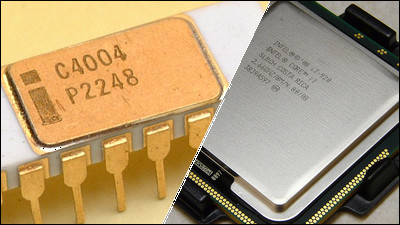Looking back on the history of Intel CPU as a representative model, this is

The history of the world's largest semiconductor maker Intel's product, that is, the history of semiconductors, is not an overstatement, and if you look at its representative model, you can see what the semiconductor market of that era was like. Semiconductor researcherLi Xiao FengBased on presentation materials on the history of Intel CPU that Mr. opens, it looks like this when looking at all the successive Intel processors at once.
A Brief History of Intel CPU microarchitectures - history_Intel_CPU.pdf
(PDF file)https://people.apache.org/~xli/presentations/history_Intel_CPU.pdf
Intel was founded on July 18, 1968 by Robert Neuss and Gordon Moore et al. Of course Mr. Moore said "Moore's lawIt is a person known for.
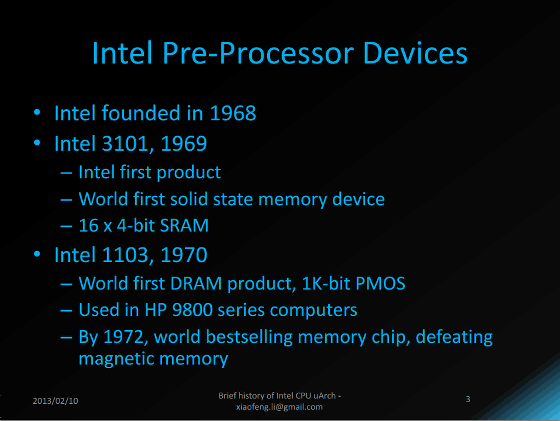
·Intel 3101
Intel's first product is "Intel 3101". It is the world's first solid state memory and the capacity was 4 bits × 16 64 bits.
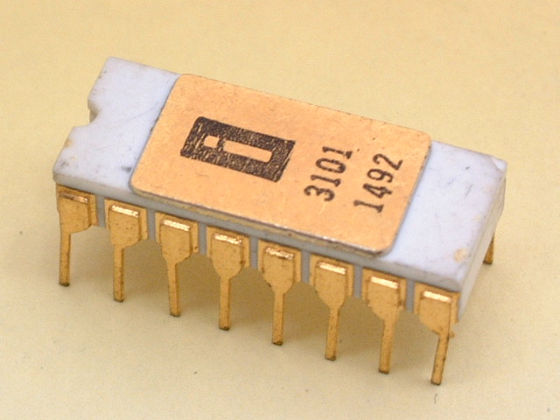
·Intel 1103
In 1970 the world's firstDRAM"Intel 1103" released. He defeated the previous magnetic memory as much as possible, and reigned as world's best selling memory by 1972.
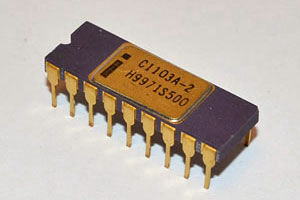
In 1965, Mr. Moore said "(PDF file)Cramming more components to integrated circuits"The complexity that minimizes the cost per part has increased about twice as much each year, and in the short term it is definitely sustainable, even though this rate of increase does not rise In the longer term, although the rate of increase is somewhat uncertain, there is no reason to believe that it will not be able to maintain a nearly constant rate for at least the next 10 years, ie by 1975, The cost of the integrated circuit parts will reach 65,000, I believe that so much larger circuits will be able to build on a single wafer. " We proposed Moore's Law which will be regarded as a technical indicator.
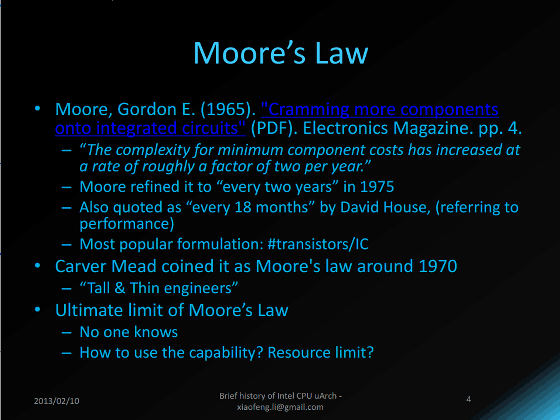
In 1975, Moore's Law was revised as "the accumulation density doubled every 2 years". Moore's Law has been maintained even in the 21st century, and attention is drawn to when that rule is broken.
Moore's law blinks yellow signal, Intel's 10 nm process shift delays surely - GIGAZINE

It is like this when summarizing CPU of Intel MCS series.

·Intel 4004
One chip microprocessor "Intel 4004" was released in 1971 as the world's first general-purpose processor. The number of clocks is 500 kHz to 740 kHz.
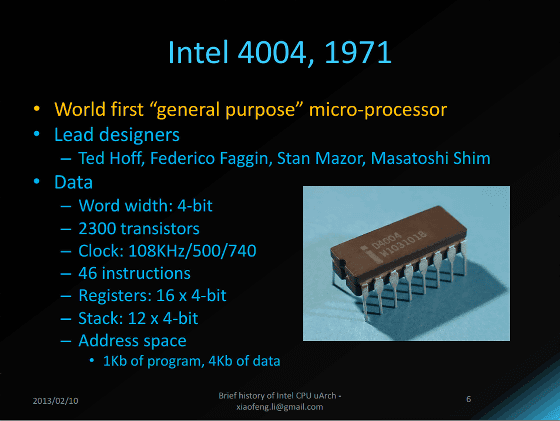
Initially, Intel 4004 is a co-developerVidiconAlthough it was a monopoly to the monopoly, Intel who noticed the versatility of the chip buy back the sales right from the vidicon, it will be sold in the world as a general-purpose chip, and it will support Intel's breakthrough. If the Intel 4004 remains a vidicon dedicated chip, the semiconductor world may have changed a lot.
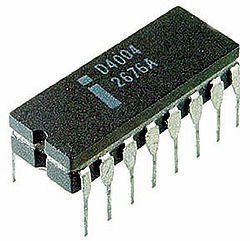
·Intel 8008
The 8-bit CPU "Intel 8008" was released in 1972, and the predecessor of the PC by Don LancasterRadio ElectronicsIt was also used for a device called "
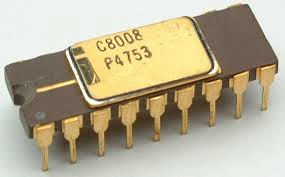
·Intel 8080
The world's first personal computer "Altair 8800"Intel's 8-bit CPU" Intel 8080 "was adopted in early PCs.
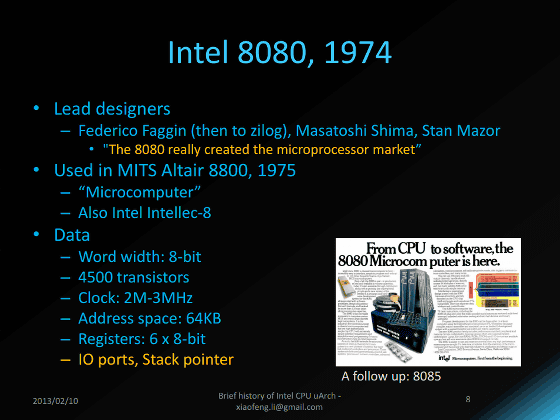
Intel 8080 developersShima MasatoshiMr. With developer privileges, Mr. Shima's family crest was carved in the corner of the pattern.

·Intel 8086
The 16-bit CPU "Intel 8086" was released in 1978. It is also known for its adoption in NEC's PC-9801 series. Bargain version of Intel 8088 was adopted by IBM PC and recorded a huge hit. With the success of Intel 8088, Intel has joined Fortune magazine's top 500 enterprises.
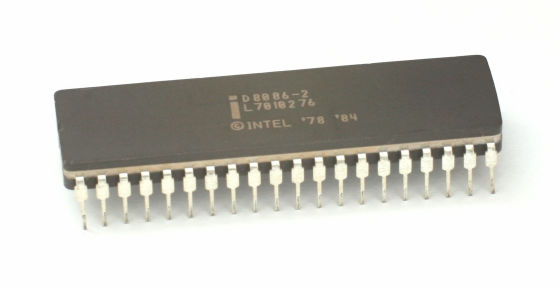
·Intel iAPX 432
The 32-bit CPU developed following Intel 8080 is "Intel iAPX 432". 16 bit CPU ·Intel 80286Because it has only one quarter of the performance, it is a commercial failure.
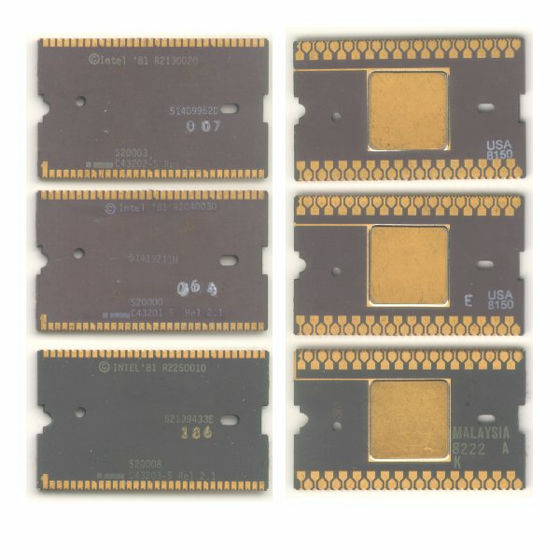
·Intel 8087
The math coprocessor developed for Intel 8086/8088 is "Intel 8087". By adding Intel 8087, the Intel 8086 realized a phenomenal performance increase of 20% to 400% up. After that, the Intel coprocessor evolved into Intel 80287, Intel 80387, Intel 80487,Intel 80486 DXAnd Pentium that it will be built in the CPU core and disappeared.
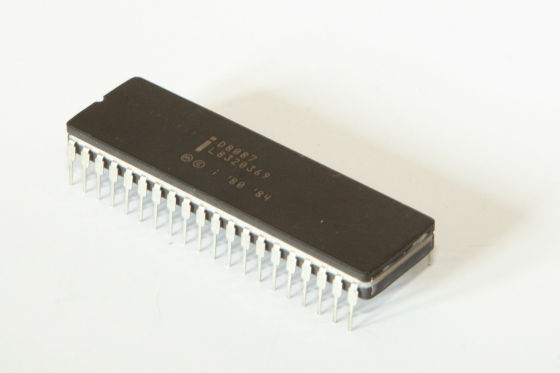
·Intel 80386
Intel 80386 released in 1985 continues from Intel 8086X86It was extended to a 32-bit instruction while taking over the architecture. However, because there was no OS that could utilize the 32-bit instruction, it was simply used as a high-speed x86 CPU in the MS-DOS environment.
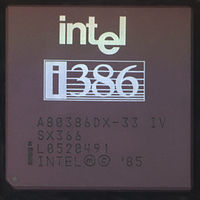
·Intel i 960
Intel's firstRISCThe base CPU "Intel i 960" appeared in 1985. Cooperative project with Siemens aiming to develop high performance multiprocessor computer "BiiN"Intel i 960 was developed by iAPX 432 development members to dispel the black history of iAPX 432.
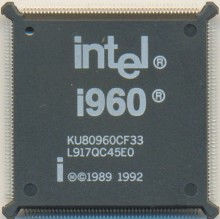
·Intel 80486
Intel 80386 successor model "Intel 80486 (i486)" was released in 1989. Together with math coprocessorCache memoryAs 8 KBSRAMIs carried. The rival was mounted on the Macintosh QuadoraMotorola 68040From AMDAm 5 x 86, From CyrixCx 5 x 86Powerful compatible models such as are also appearing.
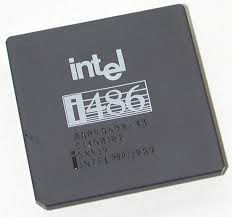
·Intel i 860
A completely failed iAPX 432 since its inception, the completely newly designed RISC microprocessor "Intel i 860" appeared rumblingly with a superb design of 32-bit ALU core + 64 bit FPU, but it is incompatible with x86 did. The market was unable to judge which Intel is predicting either i486 CISC technology or i860 RISC technology, and as a result Intel i 860 ceased development in the mid 1990's without commercial success.
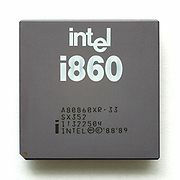
·Pentium
The i486 successor x86 architecture CPU was initially thought to appear as i586, but due to the problem that a simple combination of short numbers and alphabets is not recognized as a trademark in the United States, Intel has added a new CPU to the number "5" It is named "Pentium" which combines the Greek word "Penta" meaning and the Latin word "ium" meaning element. From then on, Intel will use brand name for CPU. In addition, Pentium is the model which installed the CPU fan for cooling for the first time.

·MMXExtended instruction set
Developed for Pentium processorSIMDThe type extension instruction set "MMX" has made it possible for the CPU to process the sound and images that the DSP had been doing. However, since MMX can only speed up to integer arithmetic processing, improvement of 3D graphics performance that requires floating point arithmetic processing can not be expected, and rival AMD3DNow!I was late.
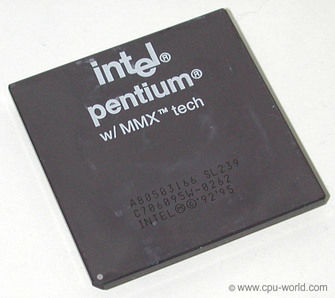
· Pentium Pro
A new design incorporating RISC technology for Pentium adopting P5 microarchitectureP6 micro architecture"Pentium Pro" adopted in 1995 appeared. It realizes the integer operation performance comparable to the RISC processor, and the supercomputer developed by IntelASCI Red"Although it was Peintium Pro that contributed to the world's most, it faced the problem of being inferior to Pentium at the execution speed of 16-bit code because it was designed specifically for 32-bit code.
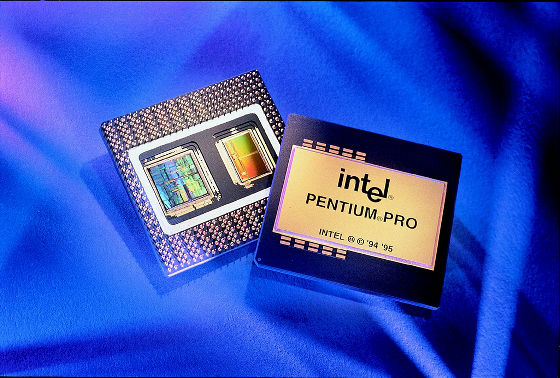
·Pentium II
Based on Pentium Pro, the L1 cache was doubled to 16 KB, and Pentium II improved the 16-bit code processing speed which was a weak point of Pentium Pro.

Because it implements the secondary cache memory that operates at half the speed of the CPU core and the CPU core on the CPU board, it became a ROM cartridge style package.

·Pentium III
In Pentium II successor model "Pentium III", AMDAthlon(K7) competing fiercely, finally broke through the crack frequency of 1 GHz. The ROM cartridge package Pentium III has been changed to the FC-PGA package in the third generation "Tualatin".

· Intel SSE
Pentium III incorporates the SIMD extension command "Streaming SIMD Extensions (SSE)" that performs floating point arithmetic processing. After that, SSE2, SSE3, SSSE3, SSE4.1, SSE4.2,Intel AVXIt evolved into.
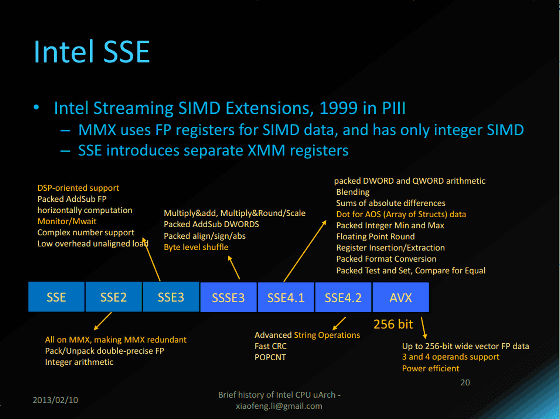
·Itanium
64 bit ISA announced joint development by Intel and HP in 1994 "IA-64"It was finally commercialized as" Itanium "in 2001 after being hit by successive development delays. Compared with the RISC processor at the time, it was not widely popular due to low performance and few applications.

·Pentium 4
It is the successor to the P6 microarchitectureNetBurst microarchitecture"Pentium 4" based on the release in 2000.Hyper ThreadingAlthough it was Pentium 4 which showed high performance such as the introduction of the Pentium 4, the high heat generation problem became serious as the miniaturization advanced from the original 180 nm process rule, to worship the Athlon 64 series of AMD.

·Pentium M
"Pentium M" was developed with the emphasis on power-saving performance on the premise of being installed in notebook PCs. However, Peintium M, which was designed based on the P6 micro architecture of the previous model rather than the NetBurst micro architecture with explosive heat problem, failed to support hyperthreading and had no performance advantage in that it had no L3 cache.
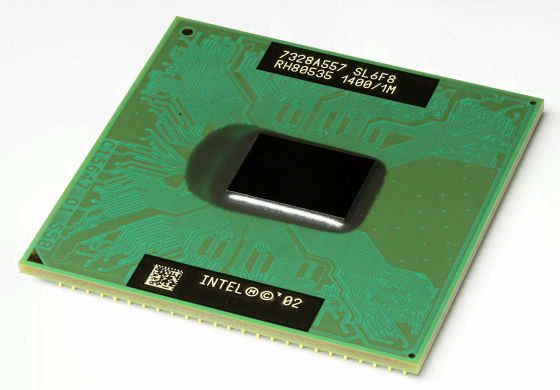
· Tick-Tock strategy
In 2007, Intel decided to adopt the "Tick-Tock" strategy that alternates between miniaturization of process rules and redesign of semiconductor circuit design every year, in the development roadmap.
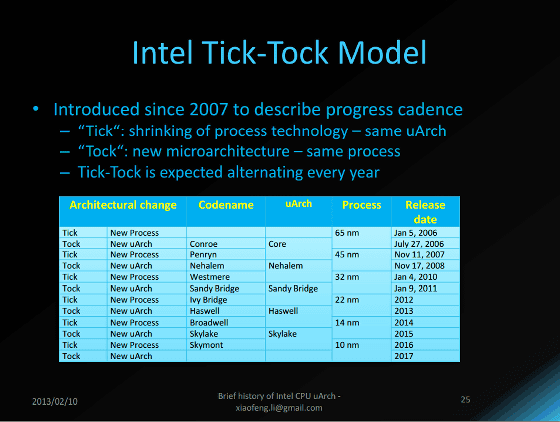
·Core microarchitecture
Core microarchitecture "developed by the Israel team aiming at compatibility between performance and low power consumption on a separate line from NetBurst microarchicature troubled by explosive heat problem. The "Core 2" series adopting the Core microarchitecture swept the market instantly from the high performance and low heat generation when released in 2006.
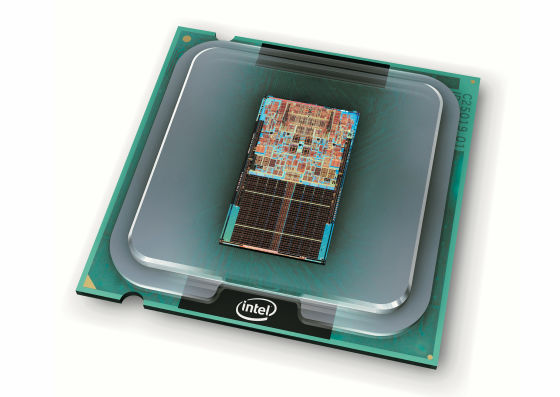
·Nehalem microarchitecture
"Nehalem microarchitecture" appeared in 2008 as a successor to the Core microarchitecture. The brand name of CPU has been changed from Core 2 series to "Core i" series, and the model number showing performance is organized into three models, Core i 7, Core i 5, Core i 3.

· Mobile terminal SoC
Since the advent of iPhone, mobile terminal market such as smartphone and tablet expands rapidly. ARM processor with excellent low heat generation performance for mobile terminalSoCWe have to sweep the market. Intel, which lagged completely with the introduction of processors for mobile terminals, has been standing in the position to follow the preceding Qualcomm and Samsung.
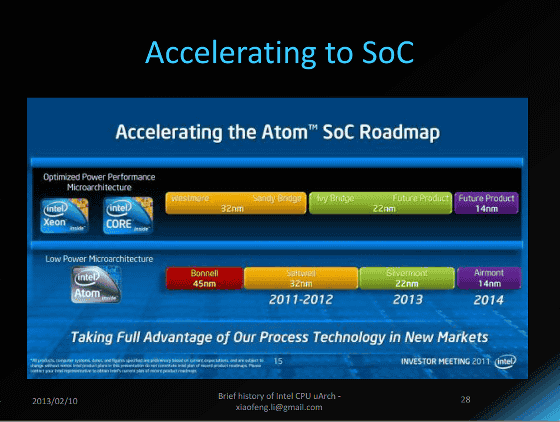
Related Posts:
in Hardware, Posted by darkhorse_log
